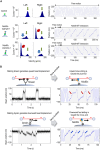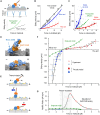Ndc80 complex, a conserved coupler for kinetochore-microtubule motility, is a sliding molecular clutch
- PMID: 40901966
- PMCID: PMC12407084
- DOI: 10.1126/sciadv.adx0005
Ndc80 complex, a conserved coupler for kinetochore-microtubule motility, is a sliding molecular clutch
Abstract
Chromosome motion at spindle microtubule plus ends relies on dynamic molecular bonds between kinetochores and proximal microtubule walls. Under opposing forces, kinetochores move bidirectionally along these walls while remaining near the ends, yet how continuous wall sliding occurs without end detachment remains unclear. Using ultrafast force-clamp spectroscopy, we show that single Ndc80 complexes, the primary microtubule-binding kinetochore component, exhibit processive, bidirectional sliding. Plus end-directed forces induce a mobile catch bond in Ndc80, increasing frictional resistance and restricting sliding toward the tip. Conversely, forces pulling Ndc80 away from the plus end trigger mobile slip-bond behavior, facilitating sliding. This dual behavior arises from force-dependent modulation of the Nuf2 calponin-homology domain's microtubule binding, identifying this subunit as a friction regulator. We propose that Ndc80's ability to modulate sliding friction provides the mechanistic basis for the kinetochore's end coupling, enabling its slip-clutch behavior.
Figures




Update of
-
Ndc80 complex, a conserved coupler for kinetochore-microtubule motility, is a sliding molecular clutch.bioRxiv [Preprint]. 2025 Mar 13:2025.03.13.643154. doi: 10.1101/2025.03.13.643154. bioRxiv. 2025. Update in: Sci Adv. 2025 Sep 5;11(36):eadx0005. doi: 10.1126/sciadv.adx0005. PMID: 40161670 Free PMC article. Updated. Preprint.
References
-
- Skibbens R. V., Rieder C. L., Salmon E. D., Kinetochore motility after severing between sister centromeres using laser microsurgery: Evidence that kinetochore directional instability and position is regulated by tension. J. Cell Sci. 108 ( Pt. 7), 2537–2548 (1995). - PubMed
MeSH terms
Substances
Grants and funding
LinkOut - more resources
Full Text Sources

